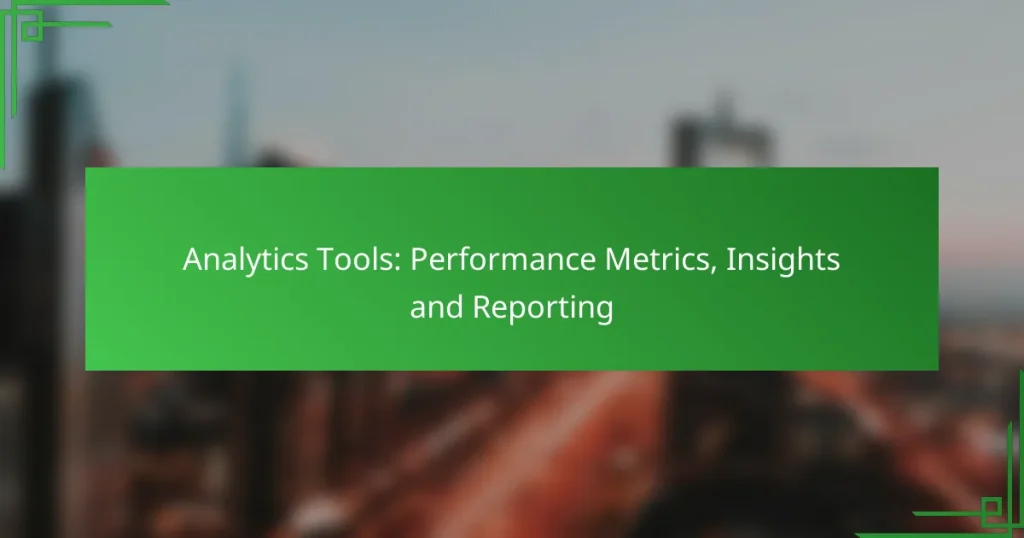Analytics tools are essential for measuring performance metrics, offering valuable insights into user behavior and conversion rates. By leveraging real-time data and customizable reporting, businesses can make informed decisions to optimize their online presence and marketing strategies. Tracking these key metrics is crucial for understanding the effectiveness of digital initiatives and driving overall business success.

What Are the Best Analytics Tools for Performance Metrics?
The best analytics tools for performance metrics provide insights into user behavior, conversion rates, and overall website effectiveness. These tools help businesses make data-driven decisions to enhance their online presence and optimize marketing strategies.
Google Analytics
Google Analytics is a widely used tool that offers comprehensive insights into website traffic and user engagement. It tracks metrics such as page views, session duration, and bounce rates, allowing businesses to understand how visitors interact with their site.
To get started, set up an account and install the tracking code on your website. Regularly review the dashboard to identify trends and areas for improvement. Be cautious of data privacy regulations like GDPR, which may affect how you collect and store user data.
Adobe Analytics
Adobe Analytics provides advanced analytics capabilities, focusing on real-time data and customer segmentation. It allows businesses to analyze user journeys across multiple channels, helping to optimize marketing efforts and improve customer experiences.
Consider Adobe Analytics if your organization requires in-depth reporting and customization. The tool can be complex, so ensure your team is trained to utilize its full potential effectively. Regularly assess your metrics to align with business goals.
Mixpanel
Mixpanel specializes in tracking user interactions with web and mobile applications, providing insights into user retention and engagement. It offers event-based tracking, which allows businesses to monitor specific actions users take within their applications.
To maximize Mixpanel’s effectiveness, define key events you want to track and set up funnels to analyze user behavior. This tool is particularly useful for product teams looking to enhance user experience through data-driven decisions.
Tableau
Tableau is a powerful data visualization tool that helps businesses create interactive and shareable dashboards. It integrates with various data sources, allowing users to visualize complex data sets and gain insights quickly.
Utilize Tableau to present performance metrics in a visually appealing manner. Focus on key performance indicators (KPIs) relevant to your business objectives. Regularly update your dashboards to reflect the latest data and trends.
Matomo
Matomo is an open-source analytics platform that emphasizes data privacy and user control. It provides similar features to Google Analytics but allows businesses to host their data, ensuring compliance with privacy regulations.
Consider Matomo if data ownership and privacy are top priorities for your organization. Set up tracking codes and customize your dashboard to focus on the metrics that matter most to your business. Regularly review your data to inform strategic decisions.

How Do Analytics Tools Improve Insights?
Analytics tools enhance insights by providing real-time data, customizable reporting, and advanced predictive features. These capabilities enable businesses to make informed decisions based on accurate and timely information.
Real-time Data Processing
Real-time data processing allows organizations to access and analyze data as it is generated. This immediacy helps in identifying trends and anomalies quickly, enabling prompt responses to changing conditions.
For example, e-commerce platforms can monitor customer behavior in real-time, adjusting marketing strategies or inventory levels instantly. This capability can significantly improve customer satisfaction and operational efficiency.
Customizable Dashboards
Customizable dashboards provide users with the flexibility to display metrics that matter most to their specific needs. Users can select which data points to visualize, tailoring the interface to highlight key performance indicators (KPIs).
For instance, a marketing team might focus on conversion rates and campaign performance, while a sales team may prioritize lead generation metrics. This personalization enhances the relevance of insights and facilitates better decision-making.
Predictive Analytics Features
Predictive analytics features use historical data to forecast future trends and behaviors. By employing statistical algorithms and machine learning techniques, these tools can identify patterns that inform strategic planning.
Businesses can leverage predictive analytics to anticipate customer needs, optimize inventory, or improve marketing effectiveness. For example, a retail company might use these insights to predict seasonal demand, ensuring adequate stock levels during peak periods.

What Key Performance Metrics Should You Track?
Tracking key performance metrics is essential for understanding the effectiveness of your digital strategies. Focus on metrics that provide insights into user behavior, conversion efficiency, and overall business performance.
Conversion Rate
The conversion rate measures the percentage of visitors who complete a desired action, such as making a purchase or signing up for a newsletter. A higher conversion rate indicates effective marketing and user experience.
To calculate conversion rate, divide the number of conversions by the total number of visitors and multiply by 100. For instance, if 50 out of 1,000 visitors convert, your conversion rate is 5%.
Improving conversion rates can involve A/B testing different elements on your site, such as call-to-action buttons, landing pages, and product descriptions. Aim for incremental improvements to see significant results over time.
Bounce Rate
Bounce rate represents the percentage of visitors who leave your site after viewing only one page. A high bounce rate may indicate that your landing pages are not engaging or relevant to your audience.
To calculate bounce rate, divide the number of single-page visits by the total number of entries to your site. A bounce rate below 40% is generally considered good, while rates above 70% may require attention.
To reduce bounce rates, ensure your content is relevant, optimize page load times, and improve navigation. Engaging visuals and clear calls to action can also help retain visitors.
Customer Acquisition Cost
Customer acquisition cost (CAC) is the total cost of acquiring a new customer, including marketing expenses and sales efforts. Understanding CAC helps you evaluate the efficiency of your marketing strategies.
To calculate CAC, divide total acquisition costs by the number of new customers gained in a specific period. For example, if you spend $1,000 to acquire 50 customers, your CAC is $20.
Keep CAC in check by optimizing your marketing channels and focusing on high-return strategies. Regularly review and adjust your budget allocation to ensure cost-effectiveness.
Average Session Duration
Average session duration measures the average amount of time users spend on your site during a single visit. This metric helps gauge user engagement and content effectiveness.
To find average session duration, divide the total duration of all sessions by the number of sessions. A duration of a few minutes is generally favorable, indicating that users are exploring your content.
To increase average session duration, create compelling content, enhance site navigation, and encourage users to explore related articles or products. Engaging multimedia elements can also keep visitors on your site longer.

How to Choose the Right Analytics Tool?
Choosing the right analytics tool involves assessing your specific needs, budget, and the features that will best support your business objectives. Key factors include cost, scalability, and how well the tool integrates with your existing systems.
Budget Considerations
When selecting an analytics tool, budget is a critical factor. Prices can vary significantly, from free options to premium services costing hundreds of dollars per month. Determine how much you can allocate for analytics tools and consider both initial costs and ongoing expenses.
Look for tools that offer tiered pricing plans, allowing you to start with basic features and upgrade as your needs grow. Be cautious of hidden costs, such as fees for additional users or advanced features.
Business Size and Needs
Your business size and specific analytics needs should guide your choice of tool. Small businesses may benefit from simpler, user-friendly platforms, while larger organizations often require more robust solutions with advanced capabilities.
Consider what metrics are most important for your business. For instance, e-commerce companies may prioritize conversion tracking, while service-based businesses might focus on customer engagement metrics. Tailor your selection to align with your operational goals.
Integration Capabilities
Integration capabilities are essential when choosing an analytics tool, as they determine how well the tool can work with your existing software and data sources. Look for tools that can easily connect with your CRM, marketing platforms, and other systems.
Evaluate whether the tool supports APIs or has pre-built integrations with popular applications. This can streamline data collection and reporting, ensuring you have a comprehensive view of your performance metrics without manual data entry.

What Are the Reporting Features of Analytics Tools?
Analytics tools offer a variety of reporting features that help users track performance metrics, gain insights, and generate comprehensive reports. These features typically include customizable dashboards, automated reporting, and data visualization options that facilitate informed decision-making.
Customizable Dashboards
Customizable dashboards allow users to tailor the display of key performance indicators (KPIs) to their specific needs. Users can select which metrics to showcase, arrange them in a preferred layout, and apply filters to focus on particular data segments. This flexibility enhances the ability to monitor performance at a glance.
For example, a marketing team might create a dashboard that highlights website traffic, conversion rates, and social media engagement metrics. This setup enables quick assessments of campaign effectiveness and areas needing improvement.
Automated Reporting
Automated reporting features streamline the process of generating regular performance reports. Users can schedule reports to be sent via email or made available for download at specified intervals, such as weekly or monthly. This saves time and ensures that stakeholders receive consistent updates without manual effort.
For instance, a sales manager could set up an automated report that summarizes sales figures and customer acquisition costs, allowing for timely adjustments to strategies based on the latest data.
Data Visualization Options
Data visualization options in analytics tools transform raw data into easily digestible formats, such as graphs, charts, and heat maps. These visual representations help users quickly identify trends, patterns, and outliers in their data. Effective visualizations can significantly enhance understanding and communication of complex information.
For example, a line graph showing monthly sales trends can quickly reveal seasonal fluctuations, while a heat map might highlight areas of high customer engagement on a website. Choosing the right visualization type is crucial for conveying the intended message clearly.

